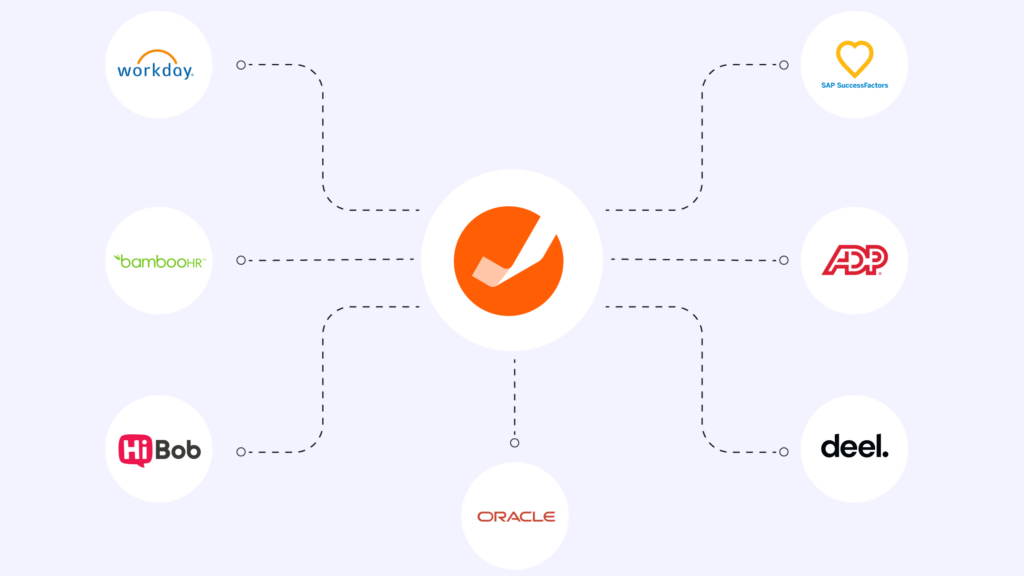A merger happens when two or more companies join forces to create one new company. An acquisition is when one takes over another: either by force or agreement. Attempted M&A happens all the time. But successful ones rare. Between 70% and 90% fail. That’s typically because key people leave, restructuring happens, or disengagement sets in. M&A is exciting and stressful in equal measure. But whether it’s a welcome union or a hostile takeover, they are times of immense change and uncertainty for everyone involved. HR and business leaders must anticipate and plan for the impact on your people when managing mergers.
Why managing people during mergers or acquisitions needs your focus
Engagement, performance, and wellbeing really matter when it comes to having happy, healthy, and productive people. In turn, this helps your business thrive. Even during times of great change and uncertainty.
Employee wellbeing is more than just how happy someone seems. It’s about finding balance. The recipe is simple: Healthy employees = healthy business. Managers, leaders, and HR have a moral responsibility to look after their employees. That starts by having clear strategies for managing people during mergers, acquisitions or other company structural changes. Focus must be laser-sharp as employees battle increased stress and worry.
Employee engagement affects just about every aspect of your organisation: profitability, revenue, customer experience, employee turnover, and wellbeing. It creates better processes and enables better management, so your people are happier and more productive. This leads to better morale, more satisfied customers, higher-quality products, less employee turnover, and higher profits.
Employee performance is a life-saver in times of crisis. Whilst measuring productivity is important, understanding performance is even more so when it comes to impacting wider business areas and keeping your people central to planning through tough times.
Employee retention is important during M&A activity
M&A can present an excellent shortcut for breaking into new markets or acquiring skills and infrastructure that would otherwise take many years to develop. One downside is the constant activity leading to a disjointed mess of different systems, processes, cultures, and purpose.
The big challenge is retention. M&A can often lead to staff turnover, and a badly handled one can amplify that. In these times where it’s becoming more and more important to hold on to your top talent, businesses can’t afford to lose their best people.
The impact on trust in management is another focus. Your people, on the whole, will have a decent level of trust in you built up over years of service. All of a sudden that can be in jeopardy with new owners coming in. You need to get off to the right start to ensure you build credibility and protect trust.
Transparent, regular communication is key. That can be a real challenge as planned and legal restrictions dictate when you can start to talk about it. But getting your communication with your people right will head off a lot of the engagement and wellbeing challenges as you’re managing people during mergers.
Keeping employee engagement high during M&A
Typically, employee engagement decreases during periods of significant change. It then rebounds once employees have more clarity about the new strategy.
M&A is certainly a time of significant change, steeped with uncertainty for all employees. Many leaders don’t survey employees until their strategic changes are implemented. Based on a misguided belief that they’ll get skewed or inaccurate data. Big mistake.
Knowing your baseline is critical to understanding how your people are handling the process. Engagement fell by an average 14% during 10 high-profile M&A activities between 2012 and 2016. And Gallup told us we needed to be concerned about a 2% drop! That’s why supporting your managers to be better at managing people during mergers is key.
And this drop in engagement can have serious consequences. Business Insider state that employee-led staff turnover can be as high as 20% following a merger.
It’s easy to understand why. Decisions affecting employee career paths and livelihoods are being made by leaders behind closed doors. When questions go unanswered, rumors fly and people become anxious and pessimistic, with their drive sapped by worries about layoffs.
Improved engagement levels and more open, transparent communication would surely help here. If you’re managing people during M&A activity now, how here’s how to grow engagement after a fall.
Managers are key to engagement during acquisitions
Sarah Middleton, Brand Integrations Communication Manager, at ERM shared:
There are a number of elements at play that can impact how engaged people remain during and post M&A. Obviously if trust is being impacted, you have recruiters on the phone trying to turn your head and rumors are flying around the office. Engagement can be negatively impacted.
Managers are huge here. Making managers a part of your M&A strategy is really important. They have a really hard job, stuck in the middle. You need to empower them to have the conversations with their teams that simply won’t happen between individual employees and leadership.
Managers can allay fears. They can provide individual responses and speak to people on the right level. All of which is helpful when it comes to keeping people engaged and happy.
You’ll see a fluctuation in employee performance during mergers
American Express looked at the impact M&A activity can have on employee performance and found four outcomes:
- Guilt: As employees see co-workers being laid off, they might face uncertainty about their own role or workload, or survivor’s guilt.
- Morale: Morale suffers when two conflicting corporate cultures merge.
- Conflict: Employees can see their new (and existing) peers as rivals rather than allies. New managers can also cause rifts.
- Motivation: Motivation drops as frustration grows with new roles, processes, cultures, and hierarchies.
This may explain why companies might see an 8-15% reduction in employee performance in the first 12 months following a merger or acquisition.
Employee wellbeing suffers during mergers and acquisitions
Wellbeing suffers during M&A. 63% of employees reported higher levels of stress and worry because of uncertainty. Worryingly, stress, anxiety, depression, psychiatric medication use, and suicide all increases following acquisitions.
Mergers and acquisitions are times of high-uncertainty, particularly when the companies involved fail to communicate openly, frequently and collaboratively with their people. Rumors begin to fly, people mention redundancies, others talk of jumping ship. Head-hunters target high-value employees at businesses about to be acquired with warnings about the ‘bad things’ they’ve heard about the acquirer and promising them the world in a new career.
When people aren’t sure what their work future looks like, it makes sense that doubt, anxiety, and panic set in. Employees from all parties involved are impacted – not just the smaller or acquired company. Employees whose careers are stalled, blue-collar workers, and employees with lower cognitive and non-cognitive skills are most affected.
Communication is critical for line managers and leaders managing people during mergers. Empower your managers and HR teams to communicate effectively with open, frequent communication.
What managers can do to support employees during M&A
Managing people during mergers is different. It needs fast decision making and utter clarity. Here’s how you can be a better manager during mergers or acquisitions.
1. Build a resilient workforce
Happy and healthy are more likely to be engaged. And engaged people perform better. So, when it comes to uncertainty, prevention is always better than a cure. There are 8 steps to building a resilient team.
- Understand the basic elements of resilience at work
- Understand strengths and develop weaknesses
- Improve emotional wellbeing for better resilience at work
- Promote an inner drive
- Resilience at work needs you to be future focused
- Develop healthy relationships
- Support physical wellbeing
- Provide personal and professional development
2. Be open and clear with your communication
During change and uncertainty, communication is key to supporting your people. Every good leader knows the importance of overcommunicating during any structural or hierarchical changes. Urgency, transparency, and empathy help people adjust to the constantly changing conditions tough times bring.
Open, honest, and regular two-way feedback between managers and employees is one of the most effective tools for building and maintaining employee engagement. Gallup report more than 90% of highly engaged businesses put communication in their top three priorities. 81% have it in their top two.
3. Set goals for clarity and to build trust
It may seem odd but setting clear goals will keep your entire organisation on track. Everyone is focused on the same destination, just via different routes.
Setting goals during a uncertainty motivates and aligns everyone. Collaborating to set goals can help to ease stress and increase feelings of belonging and trust.
Want to see how we can support your performance management?










